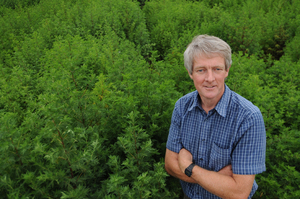
The plant extract artemisinin comes from the wormwood plant Artemisia annua. It offers the only effective alternative to the resistance problems faced by current synthetic anti-malaria drugs world-wide.
Inefficient artemisinin production and low yields in the usual growing areas in Africa and Asia have, so far, limited an effective roll-out of the treatment across the world. However, plant breeders and crop scientists at The National Institute of Agricultural Botany (NIAB) in Cambridge have significantly increased levels of artemisinin in the plant to the highest levels reported to date.
“Results from this year’s harvested Artemisia trials indicate that we’ve increased the concentration of artemisinin in excess of 2.2% w/w dry material, almost three times the industry average of 0.8% w/w. These exceptionally good results have been matched by improvements in health and vigour of the plants,” says NIAB researcher Steven Bentley.
The field trials are part of a UK-based study investigating the feasibility of growing Artemisia in the UK compared to other regions of the world, for production of artemisinin-based therapies.
The first set of project results were presented by Colin Hill, chairman of the Defra LINK Artemisia consortium, at September’s joint World Health Organisation (WHO) and Medicines for Malaria Venture (MMV) Conference on artemisinin in Mumbai, India.
“The conference was truly stunned by the achievements of NIAB’s breeding programme. For the first time delegates could see that high-yielding Artemisia was now a reality and not just a possible future goal,” reported Mr Hill on his return from the conference.
NIAB’s success is part of an ongoing breeding programme that began in 2005 developing new lines of Artemisia from original parent lines and commercial ‘varieties’.
“Our breeding programme is now established and providing consistent and stable results. We believe that additional significant increases are still possible with development material in our plant breeding nursery consistently yielding nearly twice the artemisinin concentrations over the controls that were the best varieties or lines available at the start of the project,” says Mr Bentley.
For further information contact:
Steven Bentley, non-food crops project manager, NIAB
T: 01223 342271
M: 07745 227052
E: steven.bentley [at] niab.com ()
Colin Hill, chairman Defra LINK Artemisia Consortium, BDL
T: 01622 815559
M: 07803 132553
E: colin.hill [at] botanicaldevelopments.com ()
Dr Lydia Smith, non-food and novel crops, NIAB
T: 01223 342242
M: 07809 086766
E: lydia.smith [at] niab.com ()
Issued by:
Ros Lloyd, Front Foot Communications
T: 01487 831425
E: ros.lloyd [at] frontfoot.uk.com ()
